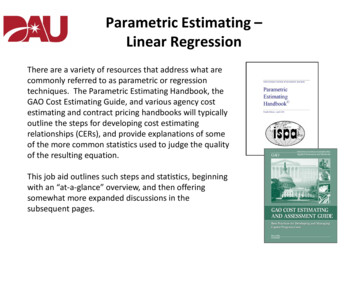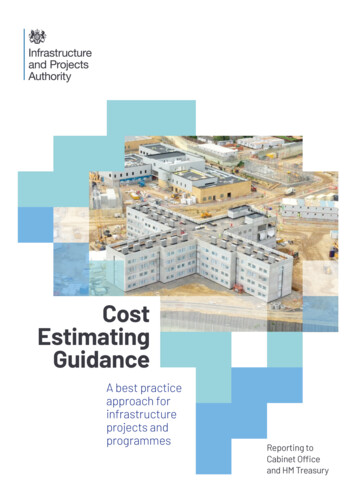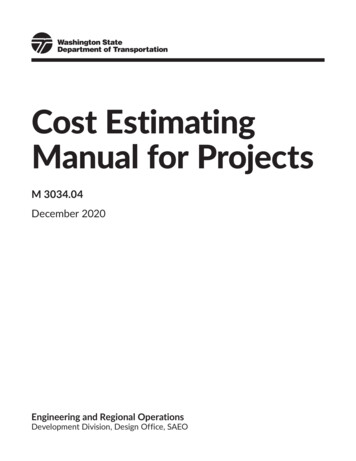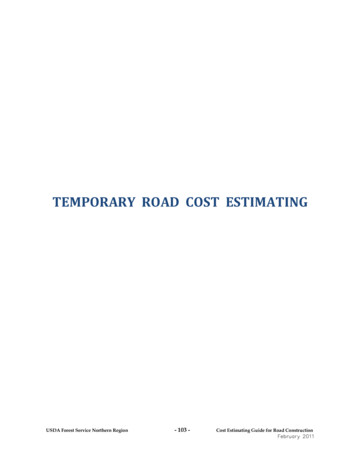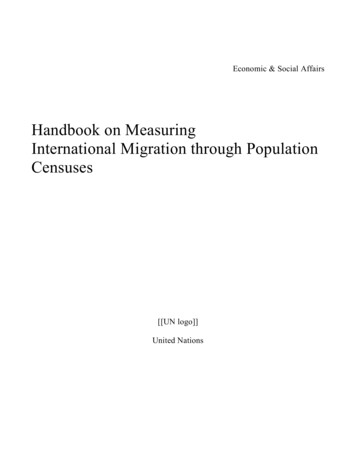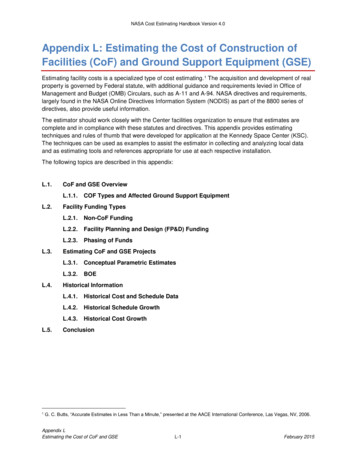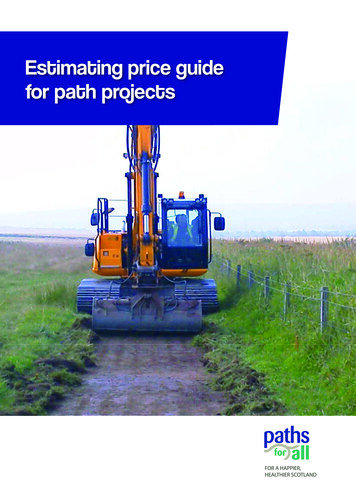
Transcription
Estimating price guidefor path projects
Supported byDesigned and printed byThe Inglewood Press Ltd, Alloa, Scotlandwww.inglewood-press.co.uk2PATHS FOR ALL
ContentsUsing this guide . . . . . . . . . . . . . . . . . . . . . . . . . .4Units of measurement . . . . . . . . . . . . . . . . . . . . .4Welfare facilities . . . . . . . . . . . . . . . . . . . . . . . . . .5Site clearance . . . . . . . . . . . . . . . . . . . . . . . . . . .6Removing an old structure . . . . . . . . . . . . . . . . . .7Earthworks . . . . . . . . . . . . . . . . . . . . . . . . . . . . .8Revetments . . . . . . . . . . . . . . . . . . . . . . . . . . . . .9Drainage . . . . . . . . . . . . . . . . . . . . . . . . . . . . . . .10Path surfaces . . . . . . . . . . . . . . . . . . . . . . . . . . .14Boardwalks and bridges. . . . . . . . . . . . . . . . . . . .18Steps. . . . . . . . . . . . . . . . . . . . . . . . . . . . . . . . . .20Fences . . . . . . . . . . . . . . . . . . . . . . . . . . . . . . . .21Gates . . . . . . . . . . . . . . . . . . . . . . . . . . . . . . . . .23Benches . . . . . . . . . . . . . . . . . . . . . . . . . . . . . . .30Signage . . . . . . . . . . . . . . . . . . . . . . . . . . . . . . . .31Glossary of terms . . . . . . . . . . . . . . . . . . . . . . . .33A cross section of a new path . . . . . . . . . . . . . . .34Acknowledgements . . . . . . . . . . . . . . . . . . . . . . .35PATHS FOR ALL3
Using this guideWe have created this guide to help you to estimate the cost of your pathproject.It is divided into sections so you can calculate the cost of different types ofwork, for example, clearing a work site, putting in drains or a gate.All of the prices are based on the cost of a contractor supplying the itemand carrying out the work for you. VAT is not included in the prices. Allprices are correct at August 2014.If you need any help using this guide, please get in touch with us at Pathsfor All by telephone on 01259 218888, or email info@pathsforall.org.ukUnits of measurementWe have used the following abbreviations for measurements:4PATHS FOR ALLUnitAbbreviationmillimetremmmetremsquare metrem2cubic metrem3
Welfare facilitiesBefore you get started on your project there are a couple of things tothink about. If you’ve got a large scale project, you might need to (wherereasonably practical) provide welfare facilities on site. You will need tocheck if this applies to your project.The contractor will install huts or cabins on site so the construction workerscan wash their hands, take breaks, make hot drinks and food, store dryclothing and equipment. They will also need a toilet. These facilities mustbe maintained until the contract is finished.Estimated costs for welfare facilitiesItemOn site welfare facilitiesInstalling, servicing and removing welfarefacilities (toilets, hand washing room, restroom, storage and drying-room).Range Average Cost 307.50 to 709per facility 534.31PATHS FOR ALL5
Site clearanceClearing vegetationBefore you can put in a path, you might have to cut back some of thevegetation to clear the way. Cutting back will allow people to see along thepath, reduce maintenance costs, and give your contractor space to work.You may have to cut back shrubs, or overhanging branches. Below aresome prices for this work.Tree fellingIf you need to take down trees, this will cost more depending on the sizeof the tree, its location, and if there are any buildings or power-lines nearby.If you have no experience of tree work, you should ask a tree surgeon foradvice.Estimated costs for site clearanceItemRange Average CostClearing vegetation (scrub)Clear existing vegetation and stack on siteLight scrub clearance 4.00 to 4.45 per m 4.23 10.00 to 50.00per tree 30.64 40.90 to 400.00per tree 220.45Felling treesCut down individual trees, stack logs, andchip the remaining branches on site with awood chipperTrees less than 0.5m girthTrees more than 0.5m girth6PATHS FOR ALL
Removing an old structureThere might be an old or rotten structure that you need to take downbefore you can build another. For example, you might want to remove afence, an old bridge, a rotting stile, or a rusty kissing gate. Or you may haveto remove existing paving.Estimated costs for removing an existing structureItemRange Average CostLift pavingBreak up foundationsRemove waste to licensed tip 3.50 to 6.00 per m2 4.75Lift a concrete or stone kerbBreak up foundations 13.50 to 17.50 per m 15.08Remove waste to licensed tipRemove and dismantle a fenceBreak up foundationsRemove waste to licensed tipTimber post and wire fencingTimber post and rail fencing 1.08 to 3.33 per m 1.97 4.33 per m 4.33 40.00 to 72.00 per item 3.87 to 5.97 per item 56.00Remove and dismantle a structureBreak up the foundationsRemove waste to licensed tipGates and stilesBins, bollards, and signs 4.92PATHS FOR ALL7
EarthworksEarthworks mean just that - moving large loads of earth or stonesaround your site to re-shape the landscape. You may be able to re-usethe materials you already have on site or you may have to bring in newmaterials, for example large stones or soil. Do not forget to add in the costof taking away waste material (also called ‘spoil’).Be aware that you might find ‘soft spots’ in the bottom layer of your pathif the ground is wet or boggy, or if the soil turns out to be heavy clay.Unfortunately, you might not be aware of soft spots until you actually startdigging. This is why you need a contingency fund. Contingency funds areincluded below.Estimated costs for earthworksItemRange Average Cost 47.32per m3 47.32Filling the ground with imported soil 20.45 to 31.00 per m3 25.73Removing old material to licensed tip 7.50 per m3 7.50Digging soft spots in specific areas andfilling in with imported hard stone materials 49.50 to 70.35 per m3 59.93EarthworksReducing the gradient of a slope8PATHS FOR ALL
RevetmentsA revetment is a structure designed to hold back soil and prevent landslippage. The height of the revetment will depend on the height of theslope.Revetments are made from various materials such as wire baskets filledwith stone (called “gabions”), recycled plastic, cement-filled sandbags,stone, willow, turf, etc.Estimated costs for a revetmentItemPlastic board revetmentBoards - 75 x 150 x 3100mmPosts - 80mm squarePosts installed 1m apartSet in concrete 500mm deepRange Average Cost 19.76 to 27.12 per m 23.44PATHS FOR ALL9
DrainageThere may be sections of your path where water is a problem. You will needto pay proper attention to drainage to stop water damaging the path. Youhave a range of choices.DITCHA ditch is a simple, open dug out channel with sloping sides. If you have plentyof room beside your path, you can dig out a V-shaped ditch. If you do not, youmight have to settle for a U-shaped ditch.If you only need a short length of ditch, volunteers can usually dig that out butbe aware that this can be physically demanding work. Contractors can easilydig out several metres with a ditching bucket fitted on the end of a digger.SWALEA swale is a wide shallow ditch lined with turf. It catches larger volumes ofwater, and slows down any water running off steeper slopes. A grassy swalelooks nicer than an earth ditch in the landscape. With a digger, the groundvegetation is stripped back and the turf and soil carefully laid aside. The swaleis dug at least 200mm deep x 1m wide, or 200mm x 2m if you need it tobe wider. The sides and bottom are re-lined with soil and turf so that it looksgrassy again.SOAKAWAYA soakaway is a deeper trench dug in the shape of a cube, away from the path.The trench may be lined with a geotextile sheet. A soakaway allows the water onor around the path to soak back into the ground. This may take some hours so itis best to dig your soakaway in an area of ground that drains well, or does not holdwater when it rains heavily.10PATHS FOR ALL
FRENCH DRAINA French drain is a trench containing a flexible plastic pipe with holes in it. Thetrench may be lined with a geotextile sheet. The trench and pipe are backfilledwith free draining gravel.French drains are used to catch surface water if you don’t want an open ditch,or if you don’t have space for one. The gravel and pipe must be kept free of siltto make sure it keeps working properly.PIPED CULVERTA piped culvert is a plastic pipe, which runs underneath the path, from one sideto another. They are placed under the path at any points where the path mightflood. Normally, there is an open ditch at each end of a culvert to let water inone end and out the other. At each end of the pipe, a stone headwall is built, tosurround and support it.The pipe has to be wide enough to let water flow through freely. If the pipeis too narrow, it could force the water to back up and onto the path, causingdamage.The pipe is made of strong plastic, is easy to cut, and is lightweight and fairlycheap to buy.PATHS FOR ALL11
Estimated costs for drainageItemV ditchDitch dug by machine150 - 300mm deep channelSides angled 45 for stabilityDug materials spread over ground to theside of the pathU ditchDitch dug by machine200 - 300mm deep channel(300 - 450mm wide at top)Sides angled slightly for stabilityDug materials spread over ground to thesideRange Average Cost 1.93 to 5.50per m 3.02 0.75 to 3.00per mSwaleCut and lift turfs by machinePlace to side for re-use 4.46 to 10.67Ditch channel dug by machineper m200 - 300mm deep channel(1000 - 2000mm wide at top)Soil and turfs re-used on bottom and sidesSoakawayTrench dug by machine1000 x 1000 x 1000mm deepFill with free draining gravel (20 - 40mm)12PATHS FOR ALL 70.00 to 140.85per soakaway 1.88 7.57 116.09
ItemRange Average Cost100mm diameter pipe in 300 x 300mmtrench 16.50 to 37.00 per m 26.17150mm diameter pipe in 300 x 500mmtrench 12.00 to 20.00 per m 14.91 56.00 to 370.00per culvert 143.38 340.58 to 450.00per culvert 395.29French drainTrench dug by machineLine trench with geotextile sheetLay free draining gravel (20 - 40mm) inbottomPlace pipe in trench on top of gravelCover pipe and fill in with gravel to groundlevelPiped culvertTrench dug by machineLine trench with geotextile sheetLay Type 1 in bottomPlace plastic pipe in trench on top of Type 1Cover pipe and fill in with Type 1Build stone headwalls 150 - 450mm thickaround each end of pipe300mm diameter pipe450mm diameter pipePATHS FOR ALL13
Path surfaces1. A whindust pathThis is a more natural looking path surface and is fairly gentle underfoot.The surface is dusty, loose or ‘unbound’. To lay a path like this, you dig outa rectangular section of ground (called a “tray”). Fill it with a base material,and then top it off with a thin layer of surface material called whinstone orgranite dust.If the ground is hard and well drained, you can dig out a full tray, fill it withbase material, then surface material, and compact it all down. If the groundis soft or poorly drained, you should dig a half tray instead - as the namesuggests, that is half the depth of a full tray. When you fill in the half tray,your finished path surface will sit slightly higher above the ground so thatwater will run off it better and your path will feel firmer. To explain the twotypes of tray better, look at diagrams on page 34.If the ground is soft or the soil is heavy clay, you need to line the tray witha geotextile sheet. This is to stop soil moving up into the path weakening itand causing ‘soft spots’. Also, if the ground is very soft or wet, you will alsoneed to lay a strong plastic geogrid on top of the geotextile, to strengthenthe base layer even further.14PATHS FOR ALL
Estimated costs for a revetmentItemRange Average CostFor NEW whindust path:Full trayDug at least 100mm deepLay and roll Type 1 - 100mm deepLay and roll whinstone or granite dust 25mm 10.30 to 24.38 per m2 18.21Half tray with geotextileDug at least 50mm deepLined with geotextile sheetLay and roll Type 1 - 100mm deepLay and roll whinstone or granite dust 25mm 7.73 to 18.00 per m2 13.26 14.68 to 18.18 per m2 16.95Half tray with geotextile and geogridDug at least 50mm deepLined with geotextile sheetGeogrid placed on top of geotextileLay and roll Type 1 - 150mmLay and roll whinstone or granite dust 25mmTo UPGRADE an existing path:Vegetation scraped off and placed tosideLay and roll Type 1 up to 100mmLay and roll whinstone or granite dust 25mm 5.30 to 6.94 per m2 6.12PATHS FOR ALL15
Path surfaces2. A Toptrec pathA Toptrec path has a firmer surface, which we call ‘semi-bound’. It isa brickish-red colour and made from recycled materials such as roadplanings, blaes or crushed concrete.For best results, a contractor can lay Toptrec using specialist machinery.The recycled materials bind together better when spread with a tarmaclaying machine and rolled with a heavy roller.Estimated costs for Toptrec pathItemFor NEW toptrec path:Full trayDug at least 100mm deepLay and roll Type 1 - 100mm deepLay and roll Toptrec up to 100mm16PATHS FOR ALLRange Average Cost 18.25 to 36.10per m2 28.15
3. A tarmac pathThis surface is commonly used for cycle paths and is smooth and durable.The bitumen and hard stone stick together to create a hard ‘bound’ surfacewhen rolled. A path like this may also be called a ‘bitmac’ path. Most areabout 2-3 metres wide. Again, you will need a contractor to lay this type ofsurface.Estimated costs for tarmac pathItemFor NEW tarmac (bitmac) path:Full trayDug at least 150mm deepLay and roll Type 1 - 150mmLay and roll tarmac - 60mmRange Average Cost 31.81 to 48.81per m2 42.68PATHS FOR ALL17
Boardwalks and bridgesBoardwalks allow public access to difficult areas such as marsh andwetland while protecting habitats. They are made of timber or recycledplastic. Usually, they are installed in sensitive habitats where a path wouldnot be suitable. They can be expensive.Estimated costs for boardwalksItemRange Average Cost 91.00per m2 91.00 250.00per m2 250.00 139.46 to 218.31per m2 182.07Raised timber boardwalk with edgerailsDecking boards - 1600 x 150 x 50mmBeams – 2200mm x 100mm squareSupport posts - 100mm squareSet in 600mm well-rammed stone andearthDeck-level edging rails - 75mm squareRaised timber boardwalk withhandrailsDecking boards - 1600 x 150 x 50mmBeams - 2200 x 100mm squareHandrail posts - 1750 x 100mm squareSet in 750mm well-rammed stone andearthHandrails - 100 x 50mmLow level plastic boardwalkGrooved decking boards - 1350 x 165 x50mmBeams - 120 x 60mmCross bearers - 1600 x 230 x 80mm laidon the groundDeck level edging rails - 100 x 50mm18PATHS FOR ALL
Bridges are difficult to price because some are much more complicatedthan others are. Costs can vary as much as 300%. You have to think aboutsuch things as supports, span and site access.Estimated costs for bridgesAs a rule of thumb, the easiest of bridges will cost 500 per m2 ofdeckingA more complex bridge will cost over 1500 per m2 of deckingYou can appoint a bridge engineer to design your bridge, and give you amore accurate estimate.You can find more information about bridges in the “Path Bridges Planning, Design, Construction and Maintenance” ntrool-bridge.htmlPATHS FOR ALL19
StepsGood steps help people reach different levels of ground more easily. If youbuild ramps alongside them, more people will be able to use your path.Estimated costs for stepsItemTimber board and aggregate stepsVertical riser boardsHalf round stakes to hold risers in placeArea between risers filled with wellrammed soil and Type 1Surfaced with whinstone or granitedustRamped sleeper and aggregate stepsRailway sleepersHalf round timber stakes to holdsleepers in placeArea between sleepers filled with wellrammed soil and Type 1Surfaced with whinstone or granitedustStone stepsLarge stonesLongest side of stone dug into theslope to least half its depthHeight of step between 170mm and200mm20PATHS FOR ALLRange Average Cost 150.00per metre 150.00 52.00per metre 52.00 420.00per metre 420.00
FencesYou might need to put up a fence alongside your path to separate peoplefrom potential hazards, such as cattle with young calves, or to keep themaway from sensitive areas such as a nature reserve or a historic site.Fences can be made of either timber or timber and wire. A timber fence(also called post-and-rail fence) is made up of timber posts and horizontalside rails. The posts come already conditioned with a weatherproof androt-proof treatment.A timber and wire fence (also known as post-and-wire fence) will consistof timber posts and horizontal plain wires, or wire netting with horizontalplain or barbed wires. The netting and plain wire can be either mild steelor high tensile. High tensile is stronger. Barbed wire, used for livestockfences is made of two strands high tensile wire. Timber and wire fenceshave large posts (called “strainer” posts) to attach and strain the wires andnetting between them. They are generally placed at points where the fencechanges direction. The more complicated the shape of your fence, themore strainer posts you will need.PATHS FOR ALL21
Estimated costs for fencesItemTimber Fencing(1.07m high above the ground)Fence with four horizontal side-railsPosts - 1675 x 100 x 75mm set 1.8mapartFour side rails - 100 x 38mm nailed topostsTimber and Wire Fencing(1.07m high above the ground)Fence with seven horizontal wiresPosts - 1675 x 100 x 75mm set 5.4mapart Strainer posts - 2440 x 175 x175mmHigh tensile plain wire – 7mm x2.5mm stapled to postsFence with stock-nettingPosts - 1675 x 100 x 75mm set 1.8mapartStrainer posts - 2440 x 175 x 175mmMild steel netting (specification:HT8/80/30)High tensile plain wire - 2.5mmBarbed wire - 2 strand 12.5mmNetting and wires stapled to posts22PATHS FOR ALLRange Average Cost 17.00 to 26.33 per m 21.46 6.70 to 15.00 per m 10.85 6.50 to 14.78 per m 10.64
Gates, stiles and gapsIf a path meets a boundary, such as a wall or fence, you will need toconsider how best the path should continue – ideally through an opengap. However, sometimes a gap is no good, for example, if you need tostop livestock getting out or stop vehicles getting in. If that is the case, youmay need to fit a gate suitable for as many users as possible, includingwheelchairs users, or install bollards.The cost of fitting gates varies a lot. Much depends on the location, theground conditions, and the type of access needed.Gates will keep livestock in while allowing people to pass. They can alsodeter motorbikes. A gate should open wide enough for people to getthrough comfortably, and ideally they should open in both directions.Cyclists, horse riders, wheelchair and mobility scooter users may find gatesa little more difficult to get through. If you can’t fit a two-way, self-closinggate, the next best thing is a gate that opens in one direction only.You will have to decide if you want metal or timber gates. H-frame gatesare made of metal and comes in one piece shaped as the capital letter ‘H’.The legs and crossbar of the H-frame gate are set in concrete. For timbergates, you need two posts, one to hang the gate on and the other tosecure the gate closed. These posts are installed with well-rammed earthand stone.PATHS FOR ALL23
Estimated costs for gatesItemRange Average CostGalvanised steel gate - 1.2m wideH-frame gateTwo-way self-closing hingesEasy latch and gate stopSet in concrete 0.7m deep 350.00 to 372.00per gate 361.00Galvanised steel gate - 1.5m wideH-frame gateTwo-way self-closing gate hingesEasy latch and gate stopSet in concrete 0.7m deep 425.00 to 498.00per gate 461.50Timber gate - 1.2m wideTimber gateTwo timber posts (1.7m apart)Two-way self-closing hingesEasy latch and two-way gate catchSet in stone and earth 0.7m deep 301.00 to 410.00per gate 351.60Timber gate - 1.6 metres wideTimber gateTwo timber posts (2.1m apart)Two-way, self-closing hingesEasy latch and two-way gate catchSet in stone and earth spoil 0.7m deep 269.00 to 390.00per gate 329.51Self-closing gates (two-way opening)All gates 1.2 metres high24PATHS FOR ALL
ItemRange Average Cost 125.75 to 373.00per gate 249.38 328.00 to 368.25per gate 348.13Self-closing gates (one-way opening)All gates 1.2 metres highGalvanised steel gate - 1.5m wideH-frame gateOne-way self-closing hingesEasy latch and gate stopSet in concrete 0.7m deepTimber gate - 1.2 metres wideTimber gateTwo timber posts (1.5m apart)One-way self-closing hingesEasy latch and gate stopRammed in stone and earth 0.7m deepTimber gate - 1.6 metres wideTimber gateTwo timber posts (1.5m apart)One-way self-closing hingesEasy latch and gate stopSet in stone and earth 0.7m deep 344.00per gate 344.00PATHS FOR ALL25
A kissing gate will stop all vehicles, but allows people to pass though oneat a time. However, it is one of the most restrictive types of gate. They canbe inconvenient for people, difficult for cyclists and will prevent access tohorse riders and wheelchair or mobility scooter users.Estimated costs for kissing gatesItemKissing gates - galvanised steelAll gates 1.2 metres highLarge kissing gateH-frame gate2.6m wide gap in a fence or wallPassing space (width across hoops) 1.7mSelf-closing hingesPadlocked latch and auto latchSet in concrete 0.7m deepMedium kissing gateH-frame gate2.6m wide gap in a fence or wallPassing space (width across hoops) 1.7mSelf-closing hingesPadlocked latch and auto latchSet in concrete 0.7m deep26PATHS FOR ALLRange Average Cost 517.00per gate 517.00 439.00 to 565.00per gate 522.53
A horse stile looks like two road humps but is made with two railwaysleepers or beams at right angles across the path. It can have rails onboth sides to help people cross. A horse stile will prevent vehicles gettingthrough while horses can easily step over it. Horse stiles can put off somewalkers, so you should also consider installing a gate at the side.A large field gate will open to let vehicles in. It is heavy for most people toopen and close, so, if you need a field gate, consider fitting a smaller gateat the side.Estimated costs for horse stile or field gateItemHorse stileTwo horizontal beams or railwaysleepersFour timber posts rammed in stone/earth spoilTimber side rails attached to postsGround between beams, and to sidesof stile to be surfaced with Type 1 250mm deepMetal field gate (one-way opening)1.2 metres highGalvanised steel gate - 3.6m wideTimber hanging post - 140mmdiameterTimber slamming post - 140mmdiameterSelf-locking gate catchRammed in stone and earth 0.7mdeepRange Average Cost 650per stile 650 194.00 to 650.00per gate 331.26PATHS FOR ALL27
Speed humps can discourage motorbikes, or slow cyclists down athazards. They will cause some inconvenience for wheelchair and mobilityscooter users, but will not affect walkers or horse riders.A single row of bollards will stop all vehicles except motorbikes. They willallow walkers, cyclists, horse riders, wheelchairs and mobility scooters topass. If vehicles need access for maintenance, you can install removablebollards.Chicanes are gates or hoops, fixed one behind the other, and slightlyoffset so that people can still get through, but vehicles can’t. Chicanes canbe used to warn cyclists when they are approaching a busy road, and theywill also deter motorbikes. They might be a little inconvenient for cyclists,horse riders, wheelchair and mobility scooter users. If the gap between thegates is too narrow, some users may not be able to get through.28PATHS FOR ALL
Estimated costs for gapsItemSpeed humpsHump 4m long x 0.1m highInstalled on path with white surfacemarkingsRound bollards1.6m high x 150mm diameter bollard1.5m between bollardsInstalled 1m above groundSet in concrete 0.6m deepChicaneTwo 1.6m high x 100mm diametersteel hoopsMaximum 3m apartMaximum 100mm overlapInstalled 1m above groundSet in concrete 0.6m deepRange Average Cost 500 to 1000 each 750.00 200 to 500 each 306.00 2400 to 2500 per pair 2500per pairTo get an idea of various sorts of gates or gaps, look at the gatedemonstration area on Paths for All’s website: onstration-area.htmlPATHS FOR ALL29
BenchesWell-placed seats and benches allow people to stop and rest, or enjoy theview. You have a range of furniture to choose from.Benches come in timber, metal or recycled plastic. When you are choosingyour material, you should take account of the fire risk or vandalism in yourarea.Estimated costs for benchesItemTimber benchSeat - 2000 x 310 x 100mmSet in 500mm well rammed stone andearthHeight of seat: 450 - 520mm30PATHS FOR ALLRange Average Cost 931.00per item 931.00
SignageDirection signs help people find their way around the area without gettinglost. You should give some thought to the kind of signs you would like,such as finger posts with text, coloured way-markers on wooden posts tomark out the route, or orientation panels to let people see where they are.Metal posts are made of galvanised steel or treated with powder-coatedpaint to stop them rusting.Think of the three D’s when designing finger posts - Direction, Destinationand Distance.Lettering can either be carved out (routered) and painted, glued in withplastic inserts, or printed on adhesive vinyl.Estimated costs for finger postsItemTimber post with finger blades100mm square post, 3-3.65m highUp to 3 finger blades - 150 x 500mmText routered and painted in whiteSet in well-rammed stone and earth1m deepPlastic post with finger blades100mm square post, 3-3.65m highFinger blade(s) - 150 x 500mmText inserts in white vinylSet in concrete 1m deepRange Average Cost 900.00per signpost 900.00 355.84per signpost 355.84PATHS FOR ALL31
ItemSteel post with finger blades75mm diameter round hollow post,2-4m high1 or 2 double-sided aluminium fingerblades,190mm x 600mmWhite vinyl text on green backgroundMetal fixing clampsSet in concrete 1m deepRange Average Cost 150 to 151.00per signpost 150.50Find out more information about signage in the “Signage Guidance forOutdoor Access: A Guide to Good Practice”: gns-signs.html32PATHS FOR ALL
Glossary of termsbollardsshort upright posts, used to stop vehicles entering the pathgalvanised steelsteel coated with zinc to prevent rustgirththe measurement of a tree around its trunkgeogrida strong plastic mesh (like a mat) with open square orgeotextilea strong synthetic sheet that allows water, but not soil, tohigh tensile wirestrong fencing wire that can withstand a lot of tension whenkissing gatea gate in-between a small enclosure that allows one personmild steel wirea plain wire, not as strong as high tensile wire, but easier tored blaesred coloured industrial waste material made of crushedrouteredcarved out lettering in timberspoilsoil and stone left over from digging a hole, trench, or traystock nettingmesh netting for fencing in livestockstone headwallswalls built with stone around a pipe, to support ittype 1a natural rock crushed and screened into large and smallwhindusta crushed rock dust used as a surface layer of a pathtriangular holespass throughpulledto pass at a timework withshalestone sizes at a quarryPATHS FOR ALL33
A cross section of a new pathIf you are new to path building, it might help to see what a new path willlook like from the side. Look at cross section diagrams below to get anidea.A well-drained path crossing hard ground would look like this. Notice thatthe surface layer of the path is level with the ground. We call this a full tray.If the ground is soft or wet, the path is usually built-up above ground levelto prevent water running back on to the surface. In the diagram below, youwill see that the surface layer now sits above the ground. We call this a halftray.For more information on path building please visit www.pathsforall.org.uk.34PATHS FOR ALL
AcknowledgementsWe would like to thank everyone who contributed to the production of thisguide. Thanks to those who supplied tendered prices from path projectsacross Scotland during 2013/14, and whose expertise helped produce thisguide.Front cover photo: Loch Leven Heritage Trail, The Rural Access Committeeof Kinross-shire (TRACKS).PATHS FOR ALL35
Paths for AllOffice 8, Forrester Lodge,Tullibody Road,Paths for All is a partnership organisation,for a full list of our current partners pleasevisit our website www.pathsforall.org.ukPaths for All Partnership is a recognised Scottish CharityNo: SCO25535 and a Company Limited by GuaranteeNo: 168554 incorporated 19 September 1996 atCompanies House, Edinburgh, Registered Office:Office 8, Forrester Lodge, Tullibody Road, Alloa FK10 2HU. Paths for All Partnership 2014Alloa FK10 2HUTel: 01259 218888Fax: 01259 218488@PathsforAll
All of the prices are based on the cost of a contractor supplying the item and carrying out the work for you . VAT is not included in the prices . All prices are correct at August 2014 . If you need any help using this guide, please get in touch with us at Paths for All by telephone on 01
